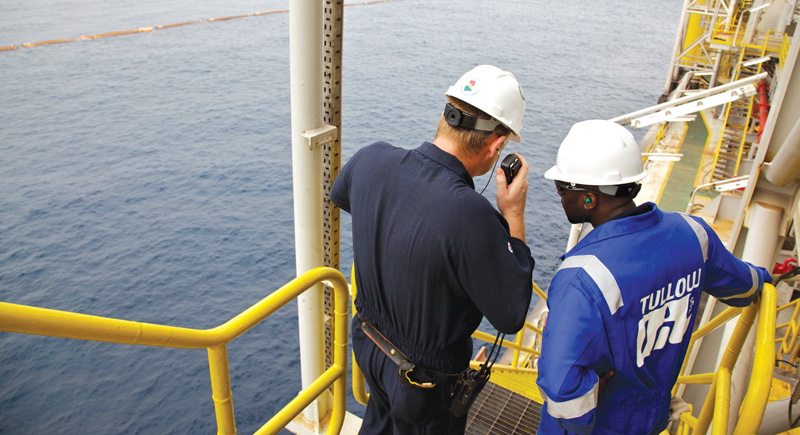
Tullow Oil says its deepwater three-field TEN project offshore Ghana is more than 85% complete and expects first oil in July or August.
The FPSO Prof. John Evans Atta Mills left Singapore on Jan. 23, with around 2,000 man hours out of a total 17 million man hours of work to be completed during the voyage to Ghana.
After its anticipated arrival in early March the vessel will be moored to the seabed location using pre-installed anchor chains and piles. This will be followed by hook-up of subsea facilities to the FPSO via flowline risers and control umbilicals.
Currently, the 11 pre-drilled wells are being completed. Final commissioning and testing of the integrated facilities will start during the second quarter, with production ramping up toward plateau later in the year.
Tullow estimates the overall capex cost for TEN at around $5 billion, excluding the FPSO lease costs. Total capex to first oil will likely be around $4 billion, with the remainder thereafter largely directed at drilling and completion of an additional 13 wells. Export of associated gas should start one year after first oil.
At the nearby deepwater Jubilee field, the company forecasts average production this year of roughly 101,000 barrels per day (b/d), reflecting the impact of a planned two week FPSO maintenance shutdown next month and reduced water injection capacity during the first half of the year. The Jubilee Phase 1A program is nearing completion.
In December last year, the company and its partners submitted the Greater Jubilee full field development (GJFFD) plan, designed to extend production and increase commercial reserves.
GJFFD has been redesigned to take into account oil price pressures, with a reduced capital requirement and greater flexibility in the timing of the capital investment.
Elsewhere in West Africa, Tullow is a partner in the Hess-operated Ceiba and Okume fields offshore Equatorial Guinea where the focus of activity last year was on improved operating efficiency and asset integrity.
A subsea workover will be completed this spring on an existing Ceiba well. At present the partners are reviewing newly acquired 4D seismic shot over the Okume complex to prepare prospects for infill drilling on Elon and Oveng during 2017.
Offshore Namibia, interpretation of a 3D survey across the PEL30 and PEL37 licenses has revealed prospectively in shallow water near the Wingat well in the adjacent license, which encountered oil in the Cretaceous.
In South America, Tullow and new partner Noble Energy are reviewing results from a 4,000-sq km (1,544-sq mi) 3D seismic survey shot last September over offshore block 54, with a view to identifying drilling prospects.
Offshore Guyana, the company is assessing prospectivity in the Kanuku license, and the partners have requested an 18-month extension to facilitate acquisition of a new 3D survey. In Uruguay, various prospects have been identified from a large 3D data set over the company’s acreage.
In the Caribbean Sea, Tullow’s 2D seismic survey is under way over the 32,056-sq km (12,377-sq mi) Walton Morant license offshore Jamaica. This is designed to delineate potential plays in shallow water.
Finally, the company was recently awarded interests in eight licenses under Norway’s 2015 APA license round. This year it will participate in four planned wells in the sector, testing the Cara prospect adjacent to the Gjøa field, Rovarkula, and the Rome prospect adjacent to Johan Sverdrup (all in the North Sea), and a horizontal well (recently spudded) on OMV’s Wisting oil discovery in the Barents Sea.
By John Kelly
























